On the Relationship between Creep Strain and Permeability of Granite: Experiment and Model Investigation
Abstract
:1. Introduction
2. Experiment on Creep-Seepage of Granite
2.1. Specimen Preparation and Experiment Equipment
2.2. Experiment Method and Procedure
3. Experiment Results and Analysis
3.1. Evolution of Creep Strain and Permeability
3.2. Characters of Acoustic Emission Hits
4. Model Investigation on Creep Strain and Permeability
4.1. A Three-Dimensional Creep Strain Model
4.2. A Permeability Evolution Model
5. Model Verification
6. Conclusions
Author Contributions
Funding
Conflicts of Interest
Notation
| Symbols | Units | Description |
| K | m2 | Permeability |
| m2 | Initial permeability | |
| Pa·s | Viscosity | |
| Pa−1 | Compressibility | |
| P | Pa | Hydraulic pressure |
| V | m3 | Volume of tested specimen |
| m2 | Cross sectional area of tested specimen | |
| m | Length of tested specimen | |
| - | Volumetric strain | |
| - | Axial strain | |
| - | Circumferential strain | |
| - | Total strain | |
| - | Elastic strain | |
| - | Viscoelastic strain | |
| - | Viscoplastic strain | |
| Pa | Stress in Nishihara model | |
| Pa | Yield strength in Nishihara model | |
| Pa | Effective volumetric stress | |
| Pa | Effective stress | |
| s | Pa | Deviatoric stress |
| Pa | The first invariant of stress tensor | |
| Pa | The second invariant of deviatoric stress tensor | |
| - | Kronecker symbol | |
| - | Coefficient of friction angle | |
| - | Coefficient of cohesion | |
| C | Pa | Cohesion |
| ° | Friction angle | |
| Pa | Elastic mudulus of the elastic part in Nishihara model | |
| Pa | Elastic mudulus of the viscoelastic part in Nishihara model | |
| Pa | Shear mudulus of the elastic part in Nishihara model | |
| Pa | Shear mudulus of the viscoelastic part in Nishihara model | |
| Pa | Bulk mudulus of the elastic part in Nishihara model | |
| Pa | Bulk mudulus of the viscoelastic part in Nishihara model | |
| t | s | Creep time |
| - | Damage coefficient | |
| - | Damage coefficient corresponding to linear damage part | |
| - | Constant corresponding to dilation or shrinkage | |
| - | Fractal derivative index for the viscoelastic part | |
| Pa·h | Viscosity of the viscoelastic part | |
| - | Fractal derivative index for the viscoplastic part | |
| Pa·h | Viscosity of the viscoplastic part | |
| - | Time-dependent coefficient of viscosity | |
| f | - | Yield function |
| - | Reference of yield function | |
| g | - | Viscoplastic potential function |
| N | - | Sensitivity index |
| - | Over-stress function | |
| d | - | Damage rate |
| D | - | Total damage |
| Q | m3/s | Volume flow rate |
| n | - | Coefficient related to the connectivity of microcracks |
References
- Wang, J. High-level radioactive waste disposal in China: Update 2010. J. Rock Mech. Geotech. Eng. 2010, 2, 1–11. [Google Scholar]
- Chen, L.; Wang, C.P.; Liu, J.F.; Li, Y.; Liu, J.; Wang, J. Effects of temperature and stress on the time-dependent behavior of Beishan granite. Int. J. Rock Mech. Min. Sci. 2017, 93, 316–323. [Google Scholar] [CrossRef]
- Liu, L.; Xu, W.Y.; Wang, H.L.; Wang, W.; Wang, R.B. Permeability evolution of granite gneiss during triaxial creep tests. Rock Mech. Rock Eng. 2016, 49, 3455–3462. [Google Scholar] [CrossRef]
- Kranz, R.L.; Blacic, J.D. Permeability changes during time-dependent deformation of silicate rock. Geophys. Res. Lett. 1984, 11, 975–978. [Google Scholar] [CrossRef]
- Cao, Y.; Wang, W.; Xu, W.; Wang, R.; Wang, H. Permeability evolution of low-permeability rocks in triaxial creep tests. Chin. J. Rock Mech. Eng. 2015, 34, 3822–3829. [Google Scholar]
- Zhang, Y.; Liu, Z.B.; Xu, W.Y.; Shao, J.F. Change in the permeability of clastic rock during multi-loading triaxial compressive creep tests. Géotech. Lett. 2015, 5, 167–172. [Google Scholar] [CrossRef]
- Chen, L.; Wang, C.P.; Liu, J.F.; Liu, Y.M.; Liu, J.; Su, R.; Wang, J. A damage-mechanism-based creep model considering temperature effect in granite. Mech. Res. Commun. 2014, 56, 76–82. [Google Scholar] [CrossRef]
- Xu, W.Y.; Wang, R.B.; Wang, W.; Zhang, Z.L.; Zhang, J.C.; Wang, W.Y. Creep properties and permeability evolution in triaxial rheological tests of hard rock in dam foundation. J. Cent. S. Univ. 2012, 19, 252–261. [Google Scholar] [CrossRef]
- Lockner, D.A.; Byerlee, J.D.; Kuksenko, V.; Ponomarev, A.; Sidorin, A. Observations of quasistatic fault growth from acoustic emissions. Int. Geophys. Ser. 1992, 51, 3–31. [Google Scholar]
- Brantut, N.; Heap, M.J.; Meredith, P.G.; Baud, P. Time-dependent cracking and brittle creep in crustal rocks: A review. J. Struct. Geol. 2013, 52, 17–43. [Google Scholar] [CrossRef]
- Selroos, J.O.; Follin, S. Overview of hydrogeological site-descriptive modeling conducted for the proposed high-level nuclear waste repository site at Forsmark, Sweden. Hydrogeol. J. 2014, 22, 295–298. [Google Scholar] [CrossRef]
- Hashiba, K.; Fukui, K. Time-dependent behaviors of granite: loading-rate dependence, creep, and relaxation. Rock Mech. Rock Eng. 2016, 49, 2569–2580. [Google Scholar] [CrossRef]
- Xu, W.; Zhou, J.; Yang, S.; Shi, C. Study on creep damage constitutive relation of greenschist specimen. Chin. J. Rock Mech. Eng. 2006, 25, 3093–3097. [Google Scholar]
- Zhu, C.X.; Huai-Ning, R.; Zhu, Z.D.; Luo, R.L. Non-linear rheological damage model of rock. Chin. J. Geotech. Eng. 2008, 30, 1510–1513. [Google Scholar]
- Zhu, Y.; Liu, Q.; Kang, Y.; Liu, K. Study of creep damage constitutive relation of granite considering thermal effect. Chin. J. Rock Mech. Eng. 2011, 30, 1882–1888. [Google Scholar]
- Zhou, H.W.; Wang, C.P.; Han, B.B.; Duan, Z.Q. A creep constitutive model for salt rock based on fractional derivatives. Int. J. Rock Mech. Min. Sci. 2011, 48, 116–121. [Google Scholar] [CrossRef]
- Zhou, H.W.; Wang, C.P.; Mishnaevsky, L.; Duan, Z.Q.; Ding, J. A fractional derivative approach to full creep regions in salt rock. Mech. Time-Dep. Mater. 2013, 17, 413–425. [Google Scholar] [CrossRef]
- Wu, F.; Liu, J.F.; Wang, J. An improved Maxwell creep model for rock based on variable-order fractional derivatives. Environ. Earth Sci. 2015, 73, 6965–6971. [Google Scholar] [CrossRef]
- Wang, R.; Zhuo, Z.; Zhou, H.W.; Liu, J.F. A fractal derivative constitutive model for three stages in granite creep. Results Phys. 2017, 7, 2632–2638. [Google Scholar] [CrossRef]
- Zhou, H.; Liu, D.; Lei, G.; Xue, D.; Zhao, Y. The Creep-Damage Model of Salt Rock Based on Fractional Derivative. Energies 2018, 11, 2349. [Google Scholar] [CrossRef]
- Liu, L.; Xu, W.Y.; Wang, H.L.; Wang, R.B.; Wang, W. Experimental studies on hydro-mechanical properties of metamorphic rock under hydraulic pressures. Eur. J. Environ. Civ. Eng. 2016, 20, 45–59. [Google Scholar] [CrossRef]
- Jiang, T.; Shao, J.F.; Xu, W.Y.; Zhou, C.B. Experimental investigation and micromechanical analysis of damage and permeability variation in brittle rocks. Int. J. Rock Mech. Min. Sci. 2010, 47, 703–713. [Google Scholar] [CrossRef]
- Zhao, L.Y.; Zhu, Q.Z.; Xu, W.Y.; Dai, F.; Shao, J.F. A unified micromechanics-based damage model for instantaneous and time-dependent behaviors of brittle rocks. Int. J. Rock Mech. Min. Sci. 2016, 84, 187–196. [Google Scholar] [CrossRef]
- Chen, W.; Konietzky, H. Simulation of heterogeneity, creep, damage and lifetime for loaded brittle rocks. Tectonophysics 2014, 663, 164–175. [Google Scholar] [CrossRef]
- Chen, L.; Liu, J.F.; Wang, C.P.; Liu, J.F.; Wang, J. Creep behavior of the beishan granite under different temperature and stress conditions. Chin. J. Rock Mech. Eng. 2015, 34, 1228–1235. [Google Scholar]
- Kato, M.; Nara, Y.; Okazaki, Y.; Kohno, M.; Sato, T.; Sato, T.; Takahashi, M. Application of transient pulse method to permeability measurement for clay. J. Soc. Mater. Sci. Jpn. 2018, 67, 318–323. [Google Scholar] [CrossRef]
- Jia, C.J.; Xu, W.Y.; Wang, H.L.; Wang, R.B.; Yu, J.; Yan, L. Stress dependent permeability and porosity of low-permeability rock. J. Cent. South Univ. 2017, 24, 2396–2405. [Google Scholar] [CrossRef]
- Qi, Y.; Jiang, Q.; Wang, Z.; Zhou, C. 3d creep constitutive equation of modified nishihara model and its parameters identification. Chinese J. Rock Mech. Eng. 2012, 31, 347–355. [Google Scholar]
- Perzyna, P. Thermodynamic theory of viscoplasticity. In Advances in Applied Mechanics; Yih, C.S., Ed.; Elsevier: Amsterdam, The Netherlands, 1971; pp. 313–354. [Google Scholar]
- Zienkiewicz, O.C.; Cormeau, I.C. Visco-plasticity—Plasticity and creep in elastic solids—A unified numerical solution approach. Int. J. Numer. Method. Eng. 1974, 8, 821–845. [Google Scholar] [CrossRef]
- Wu, F.; Chen, J.; Zou, Q. A nonlinear creep damage model for salt rock. Int. J. Damage Mech. 2018. [Google Scholar] [CrossRef]
- Masad, E.; Dessouky, S.; Little, D. Development of an elastoviscoplastic microstructural-based continuum model to predict permanent deformation in hot mix asphalt. Int. J. Geomech. 2007, 7, 119–130. [Google Scholar] [CrossRef]
- Masad, E.; Tashman, L.; Little, D.; Zbib, H. Viscoplastic modeling of asphalt mixes with the effects of anisotropy, damage and aggregate characteristics. Mech. Mater. 2005, 37, 1242–1256. [Google Scholar] [CrossRef]
- You, T.; Al-Rub, R.K.A.; Darabi, M.K.; Masad, E.A.; Little, D.N. Three-dimensional microstructural modeling of asphalt concrete using a unified viscoelastic–viscoplastic–viscodamage model. Constr. Build. Mater. 2012, 28, 531–548. [Google Scholar] [CrossRef]
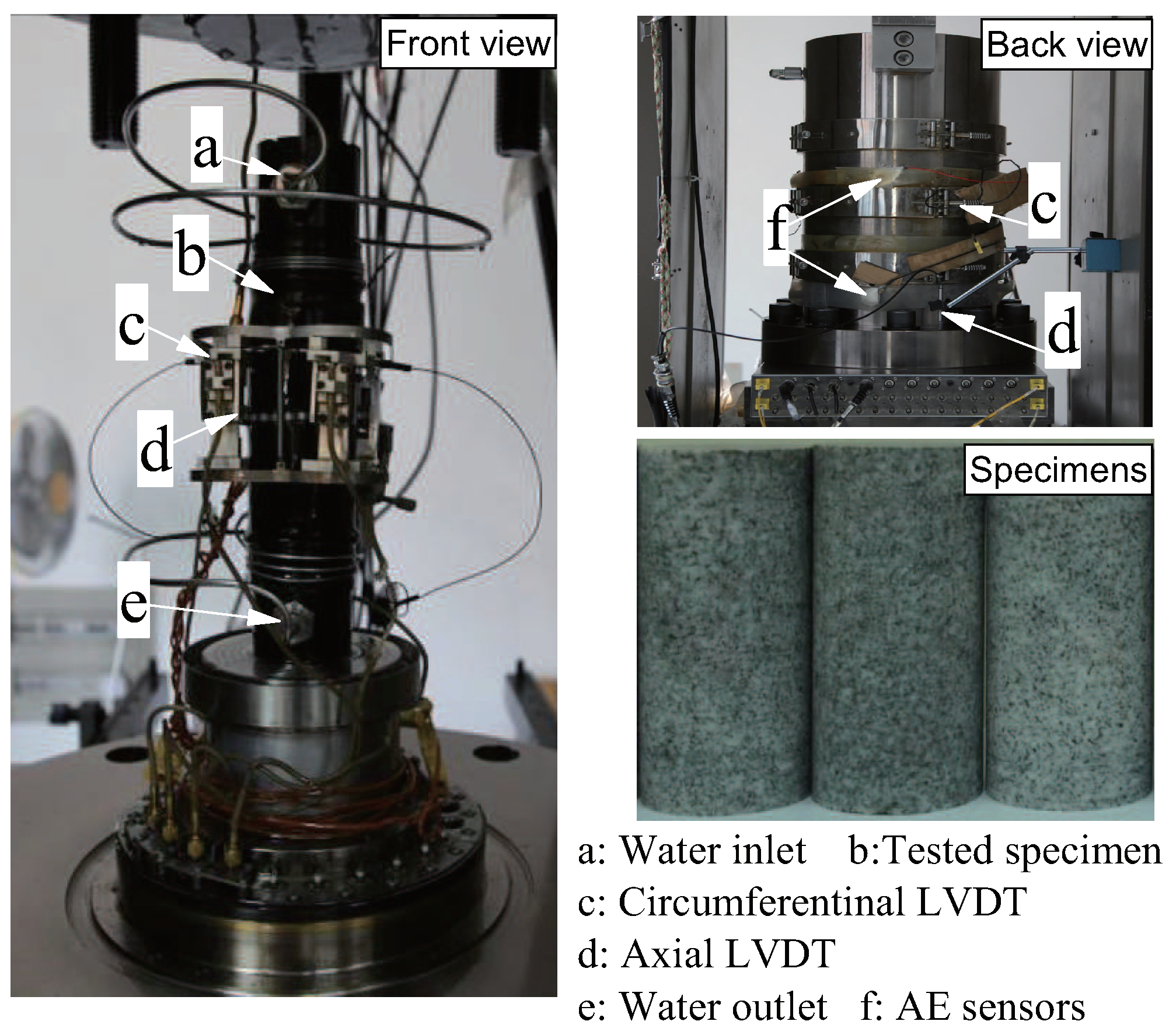

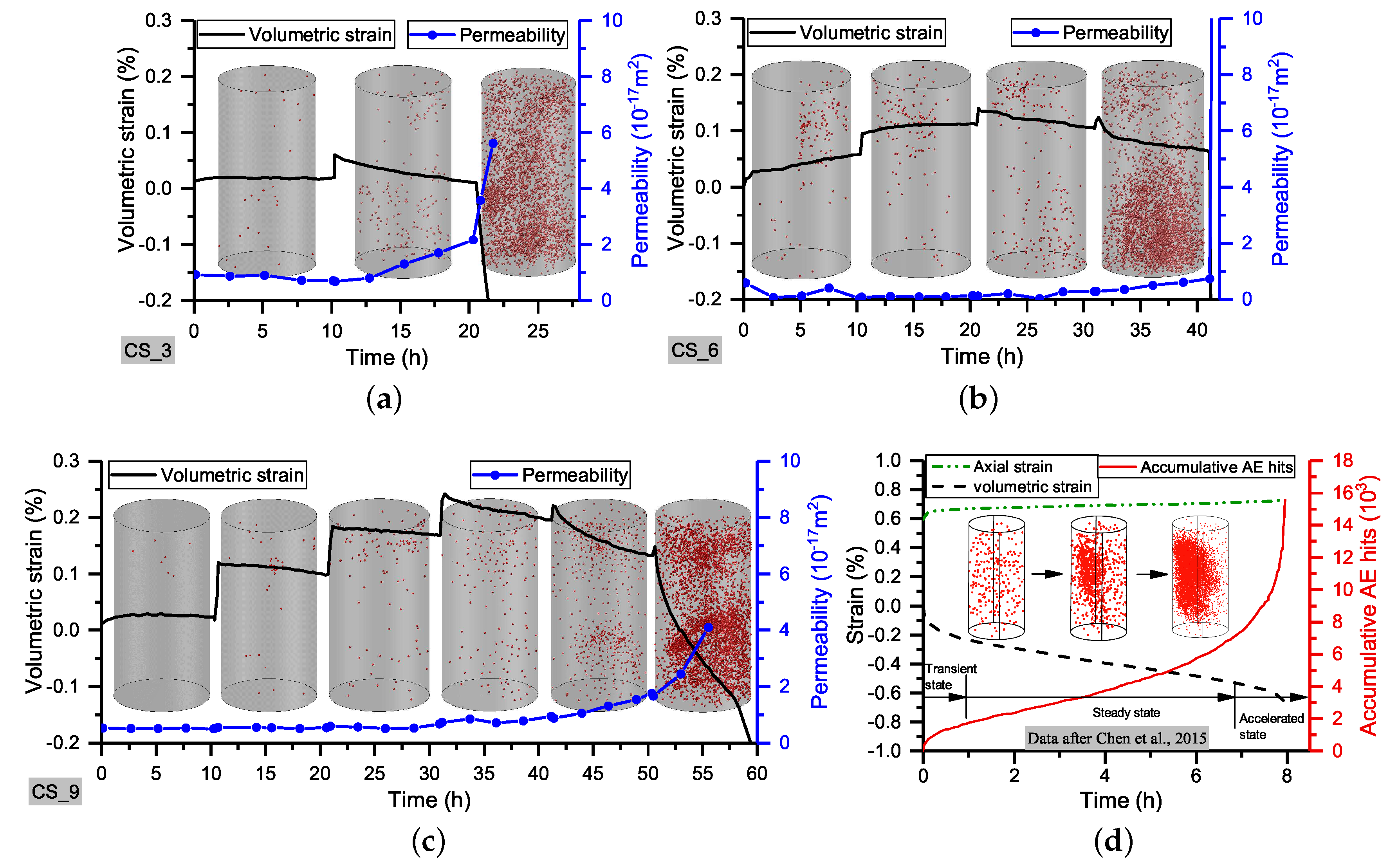
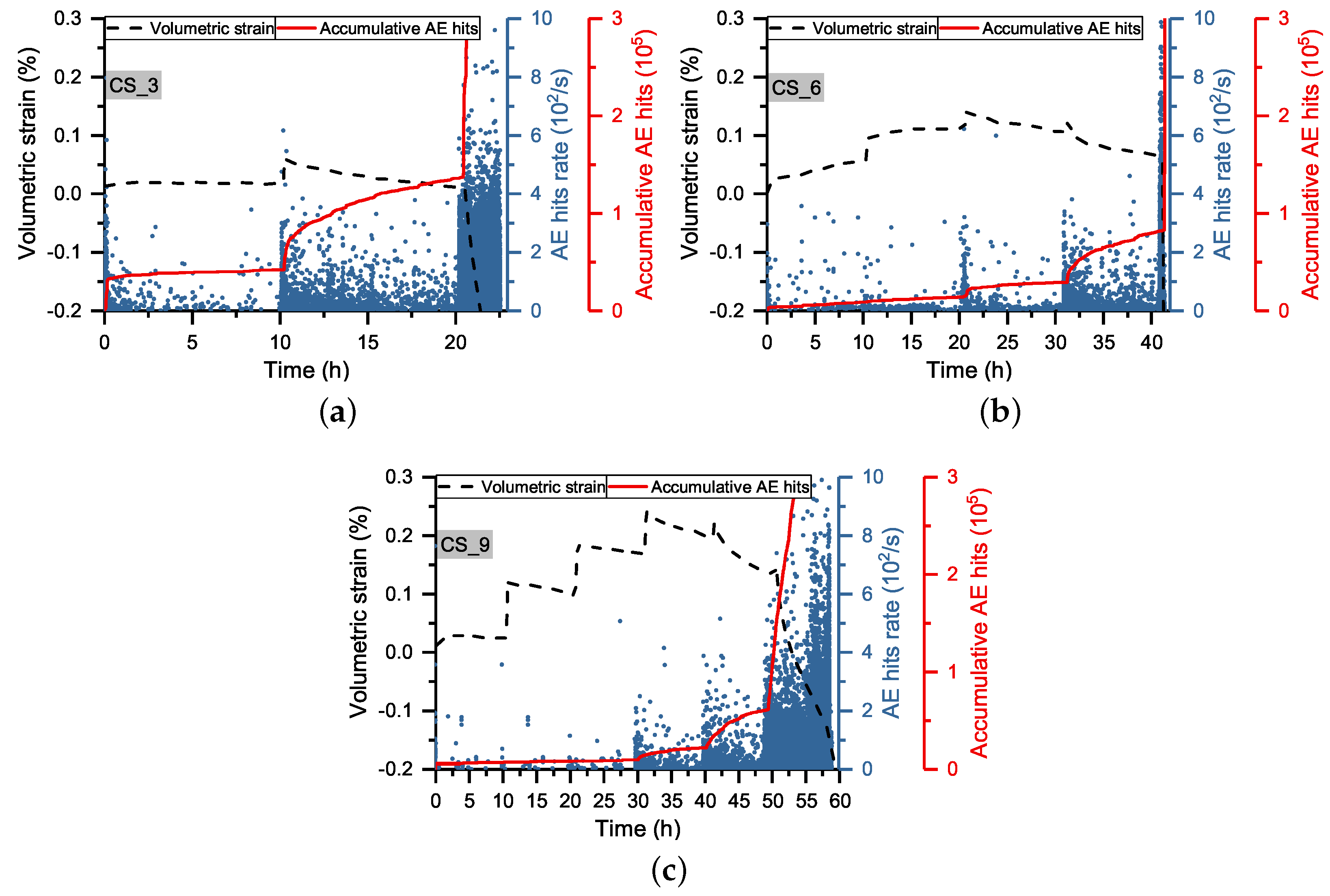
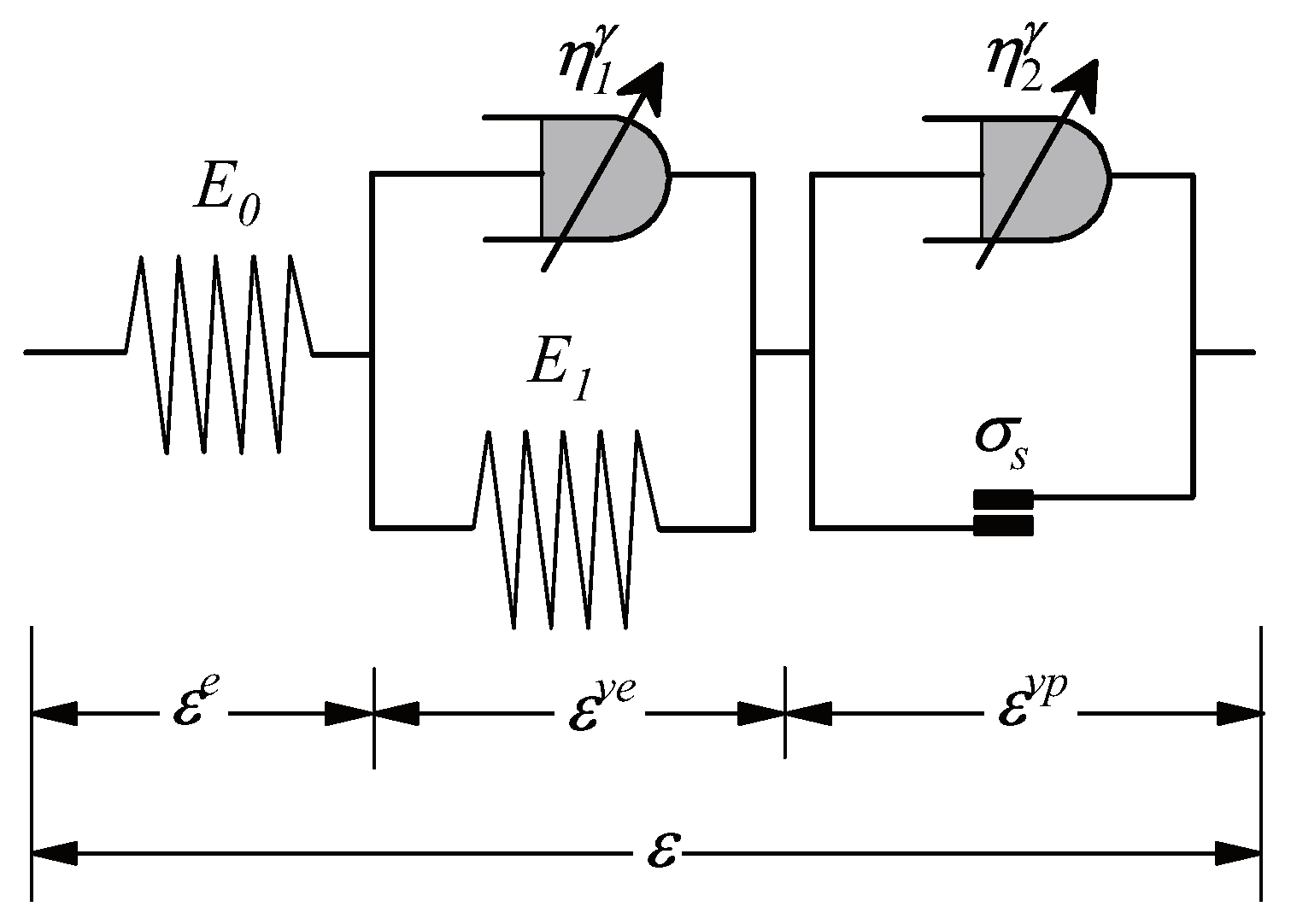

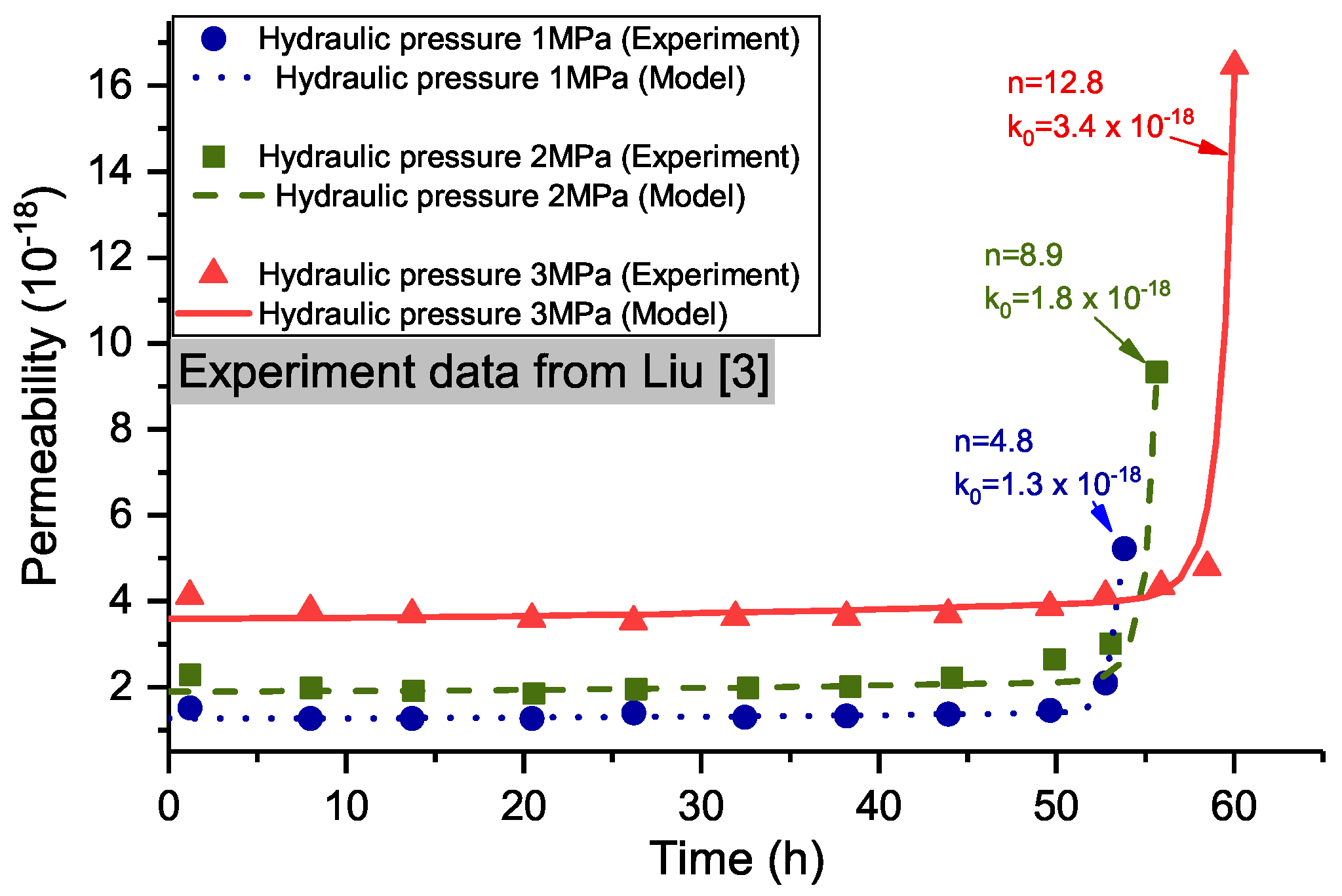
| E0 | E1 | v | C | φ | γ1 | γ2 | η1 | η2 | α | β | χ | |
|---|---|---|---|---|---|---|---|---|---|---|---|---|
| (MPa) | (MPa) | (-) | (MPa) | (°) | (-) | (-) | (GPa·h) | (GPa·h) | (-) | (-) | (-) | |
| CS_3 | 70000 | 1450 | 0.2 | 28 | 30 | 0.04 | 0.935 | 2.5 | 1.15 × 1016 | 16.9 | 0.2 | 4.15 × 1015 |
| CS_9 | 70000 | 1450 | 0.24 | 28 | 30 | 0.02 | 0.936 | 1.05 | 1.75 × 1034 | 9.63 | 0.29 | 1.3 × 1033 |
| Figure 6c | 48000 | 2700 | 0.21 | 28 | 30 | 0.01 | 0.87 | 0.87 | 4.87 × 1040 | 2.95 | 0.38 | 3.57 × 1038 |
| Figure 6d | 48000 | 2700 | 0.24 | 28 | 30 | 0.01 | 0.867 | 0.87 | 1.76 × 1041 | 2.94 | 0.32 | 1.16 × 1039 |
| Figure 6e | 48000 | 2700 | 0.25 | 28 | 30 | 0.01 | 0.467 | 0.65 | 1.76 × 1044 | 15.42 | 0.32 | 8.06 × 1042 |
© 2018 by the authors. Licensee MDPI, Basel, Switzerland. This article is an open access article distributed under the terms and conditions of the Creative Commons Attribution (CC BY) license (http://creativecommons.org/licenses/by/4.0/).
Share and Cite
Yi, H.; Zhou, H.; Wang, R.; Liu, D.; Ding, J. On the Relationship between Creep Strain and Permeability of Granite: Experiment and Model Investigation. Energies 2018, 11, 2859. https://doi.org/10.3390/en11102859
Yi H, Zhou H, Wang R, Liu D, Ding J. On the Relationship between Creep Strain and Permeability of Granite: Experiment and Model Investigation. Energies. 2018; 11(10):2859. https://doi.org/10.3390/en11102859
Chicago/Turabian StyleYi, Haiyang, Hongwei Zhou, Rui Wang, Di Liu, and Jingyang Ding. 2018. "On the Relationship between Creep Strain and Permeability of Granite: Experiment and Model Investigation" Energies 11, no. 10: 2859. https://doi.org/10.3390/en11102859
APA StyleYi, H., Zhou, H., Wang, R., Liu, D., & Ding, J. (2018). On the Relationship between Creep Strain and Permeability of Granite: Experiment and Model Investigation. Energies, 11(10), 2859. https://doi.org/10.3390/en11102859





